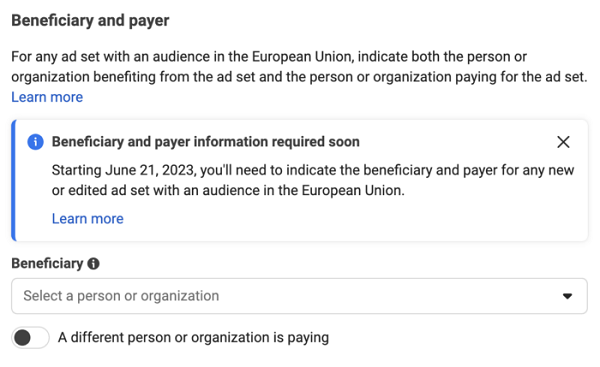If you run Facebook or Instagram ads using ‘worldwide’ targeting, or targeting EU audiences specifically, you’ll soon need to update your Meta ad targeting processes.
In line with The EU Digital Services Act (DSA), which now requires Meta to provide more information on ad targeting, Meta’s adding new elements when EU targeting is selected, which will prompt advertisers to specify a ‘beneficiary’ and ‘payer’ for each campaign.
As per Meta:
“As part of our efforts to create transparency for businesses and people, and to respond to EU regulations, we will require advertisers to designate who benefits from their ads (beneficiary) and who is paying for their ads (payer) for all Facebook and Instagram ads which target the EU, associated territories, or select global/worldwide.”

As you can see in this example, now, when you select an EU audience, you’ll be shown these new fields, and you’ll have to choose a response for each.
The information on ‘payer’ and ‘beneficiary’ is designed to facilitate more insight into the source for each Facebook and IG ad – which, in most cases, will see you simply adding your business name in both fields.
Though there are specific regulations around such, and it’s important that advertisers understand the new requirement as outlined by Meta’s team.
You can read more about the updated requirements here.
Meta’s also announced some new updates to its Marketing API, in line with the same, which will mean that developers will need to update their API usage.
“This information will be required on all ad creation surfaces beginning June 21. By the end of August, beneficiary and payer information will be displayed in the Ad Library and the Ad Library API for all ads that are created on or after June 22, 2023 and that deliver an impression to the EU or associated territories.”
The update marks the latest regulatory shift for online ads, which has already seen Meta face huge fines for non-compliance with specific elements of its evolving codes.
Indeed, just last month, Meta was fined €1.2 billion – equivalent to $1.3 billion USD – for transferring EU user data back to the US without explicit permission or adequate protections in place.
EU regulators continue to push for more transparency and control options for users, and with each update, Meta needs to evolve its systems accordingly, or risk similar penalties in future.
It’s another wrinkle in the Meta ads process, which will impact all brands that market to EU users.



